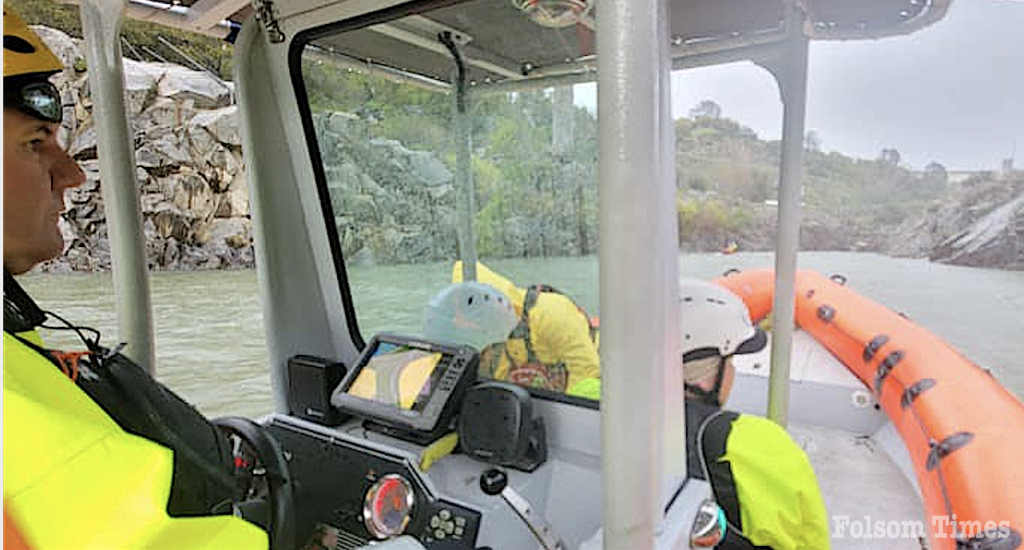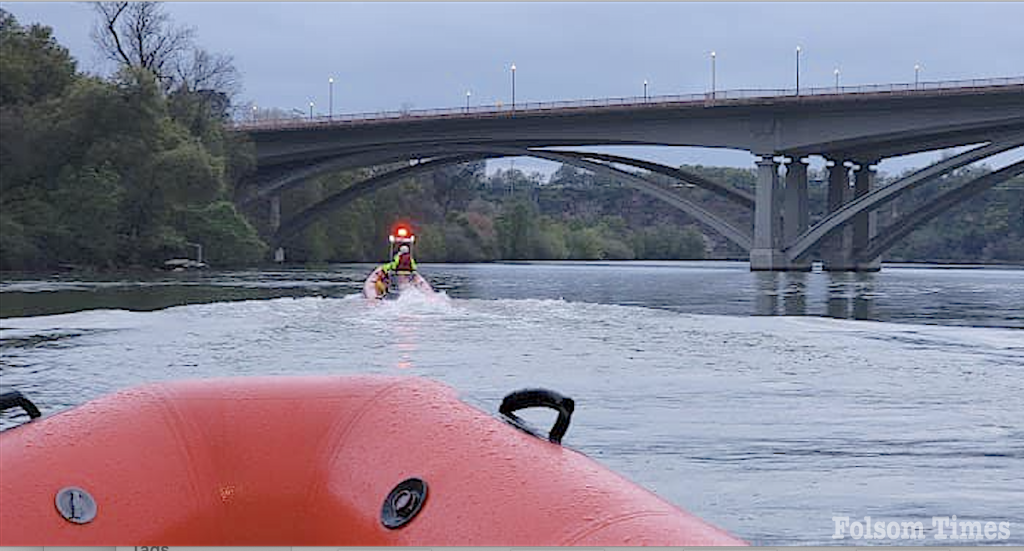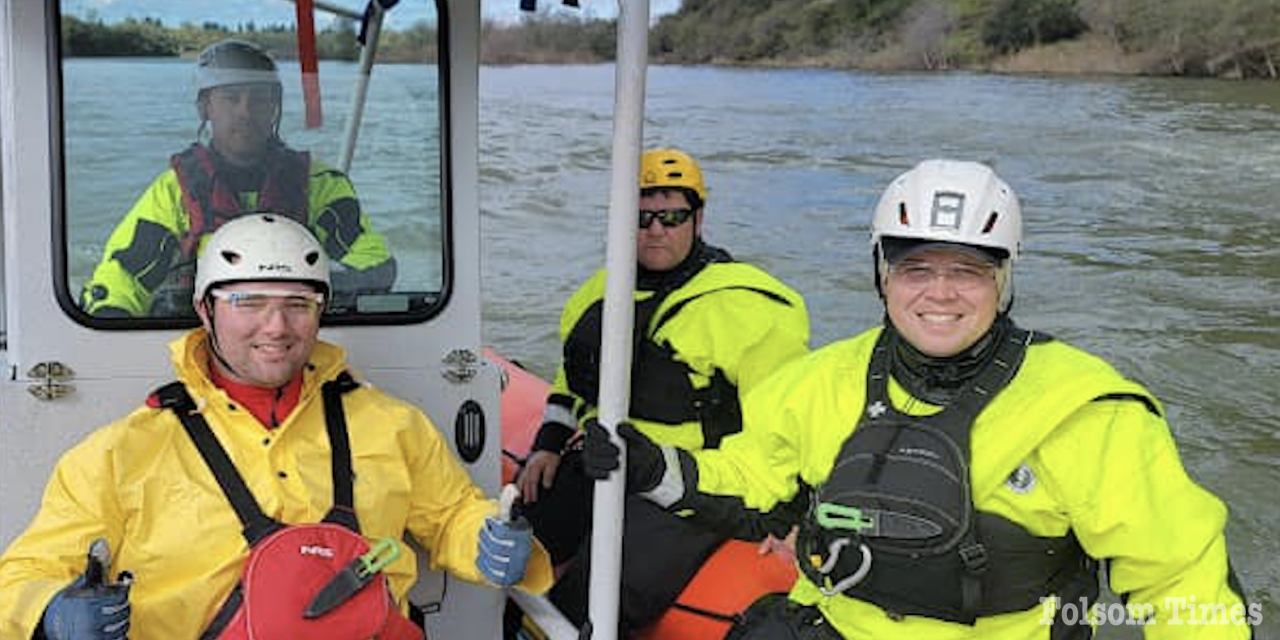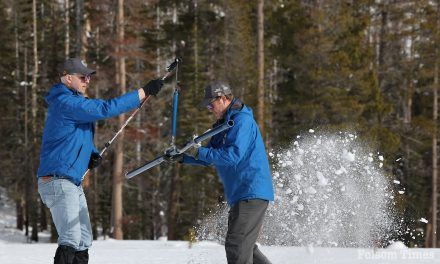With a record snowpack and a heavy runoff in the future, it isn’t breaking news that our area waterways are going to see abundant flow increases as the warmer days approach and well into early summer.
In preparation of the likely surge of water rescues and calls for assistance, the Folsom Fire Department has just completed several days of on the water training. If you were near Lake Natoma in the last few weeks, chances are you may have spotted various rescue boats and first responders on the water.
Every year the Folsom Fire Department members refresh their skills in water rescue to ensure readiness and maintain proficiency. This year, the training is exceptionally important due to the impeding conditions.
“This year the region has seen a significant increase in rain and snowfall that will make for a longer than usual water runoff time,” explained Folsom Fire Assistant Fire Chief Mark Piacentini. “We can expect the waterways to be fuller, colder, and be faster moving for most of the summer. This presents an unseen danger as many waterway visitors are not used to these conditions.”
According to Piacentini, the recent trainings that many onlookers have scene includes boat operations, swimming proficiency, and shore-based operations.


The Folsom Fire Department staffs two different rescue boats. One boat is stationed at Fire Station 35 and the other located at Fire Station 36. Both are always ready to go, along with their trained first responders when the call comes in for someone who is stranding, injured or missing on the water.
As of late, the moving current is apparent to the naked eye on Lake Natoma and other areas. Piacentini added that in the months ahead those waters may appear to be calm, but don’t be fooled by their outward appearance.
“The water may look calm on the surface but may contain faster-moving water just a few feet below the surface,” he said. “Within that faster moving water is debris such as tree limbs that can create additional hazards. We always encourage the use of personal flotation devices or life jackets when near any of our local waterways, regardless of one’s swimming abilities.”
MULTIPLE AGENCIES WARN OF DANGERS
The Calfornia Department of Parks and Recreation recently issued a news release, expressing concerns for the upcoming run off and the increased danger in area water ways.
California State Parks’ Division of Boating and Waterways (DBW), the Department of Water Resources (DWR) and the California Department of Forestry and Fire Protection (CAL FIRE) are urging the public to take extra precautions and to be aware of cold-water dangers this spring to avoid a tragedy.
The series of winter storms is causing rising river and stream flow levels not seen in years. The eventual spring warm-up will bring fast flows and cold temperatures when all that snow starts to melt. All Californians are being encouraged to wait until summer to recreate in the water, when conditions are safer.
“After successive low-water drought years, it is imperative that Californians understand water safety in and around rivers, streams, lakes and Sierra reservoirs,” said State Parks Director Armando Quintero. “As the temperature rises, snowmelt-fed waterways can quickly induce incapacitating cold-water shock to even the strongest swimmers. We encourage everyone to follow the advice of public safety officials and avoid entering waterways if asked to do so.”
“California has one of the largest snowpacks on record,” said DWR Director Karla Nemeth. “As this snowpack melts in the coming months, the waterways will be especially cold, fast and running higher than normal. Be aware of fluctuating water levels. We want everyone to always make safety a top priority when recreating.”
“This year is very different from the last several years, in that the excessive snowpack and rain will continue to create challenges for us in the weeks and months ahead. Rising water levels in rivers and streams will be very cold, very fast and can easily overwhelm those that aren’t prepared or don’t heed warnings,” said CAL FIRE Chief Joe Tyler. “Our teams will continue to focus on localized flooding risks, potential for major flooding, water rescues and our operational capabilities to support our communities moving into the spring and summer months.”
All three departments hope to educate not only regular water enthusiasts but occasional visitors to high, fast-running waterways who may venture near the edge to test the water or take selfies. Just one slip or unwatched child can become a devastating drowning statistic.
Here are some key safety points to know before heading outdoors:
Plan Ahead
Prior to leaving home, check the status of the park unit/waterway you want to visit to find out what restrictions and guidelines are in place.
Know your GPS coordinates so you can provide your location in case of emergency.
Alert someone where you are going and your expected return time. Be sure to let them know when you return safely.
Know the Water
Do not enter cold, fast-running water. It can be dangerous not only to you but also for first responders.
Many unseen obstacles can be lurking below the water’s surface – this is especially the case with this year’s expected high runoff following low water years. Drought-stricken forests and storm-driven landslides have filled rivers with submerged trees and rocks. Swift water can make these obstacles even more treacherous.
Sudden immersion in cold water can stimulate the “gasp reflex,” causing an involuntary inhalation of air or water and can start the drowning process immediately. It can even trigger cardiac arrest, temporary paralysis, hypothermia and drowning.
Never enter the water to rescue a victim. Throw something that floats and call 9-1-1.
Know your Limits
When faced with cold, swift water, even the strongest swimmers may be easily overwhelmed. Do not enter the water and never enter the water to rescue a victim. Throw something that floats and call 9-1-1.
Swimming in open water is more difficult than in a swimming pool – people tire more quickly and can get into trouble.
Never go on the water alone. If available, guided trips for solo or inexperienced floaters or paddlers are recommended.
Kow about Life Jackets
Although life jackets are strongly recommended when recreating in or near waterways, this year’s expected high runoff in rivers can be dangerous even with the use of life jackets.
Conditions change quickly in open water and even the best swimmers can misjudge the water and their skills when boating or swimming. Wearing a properly fitted U.S. Coast Guard-approved life jacket can increase survival time.
Learn more about life jackets atwww.BoatCalifornia.com.
Know how to Supervise
Actively supervise children in and around open bodies of water, giving them your undivided attention. Do not assume that someone is watching them. Appoint a designated “water watcher,” taking turns with other adults.
Teach children that swimming in open water is not the same as swimming in a pool: they need to be aware of uneven surfaces, river currents, ocean undertow and changing weather.




